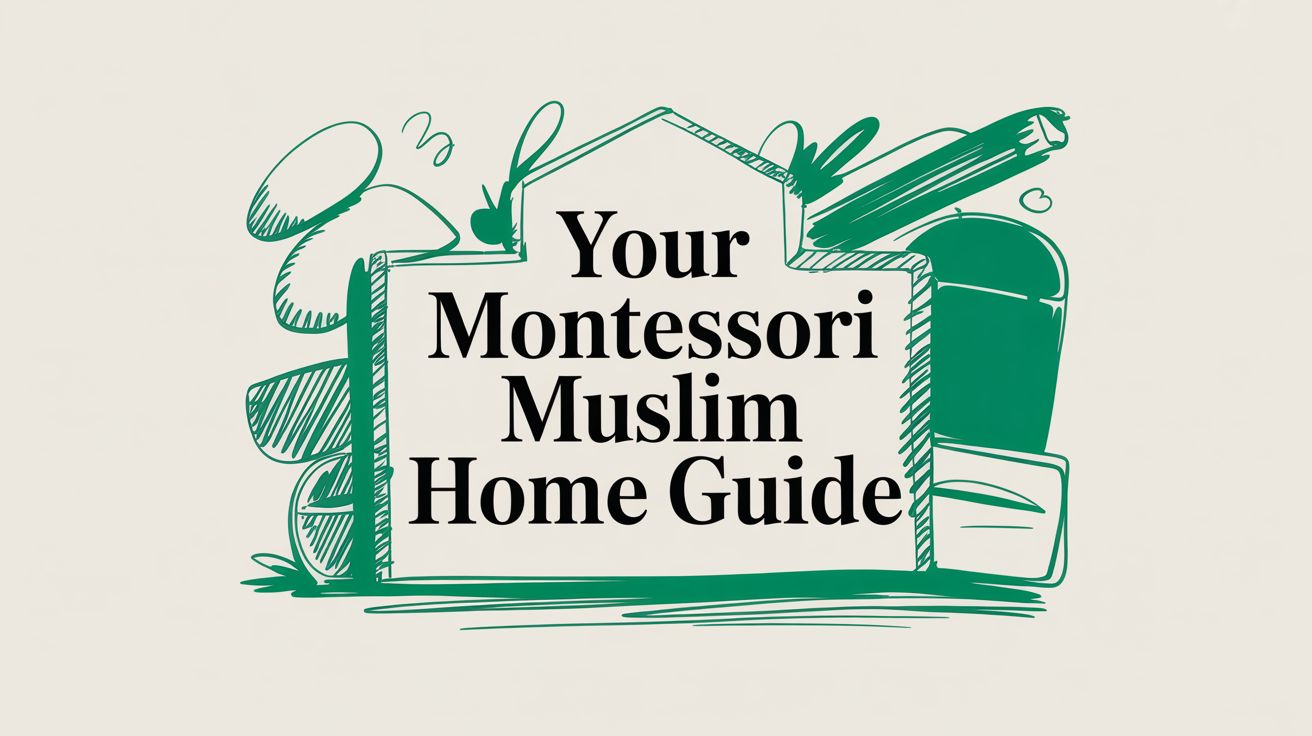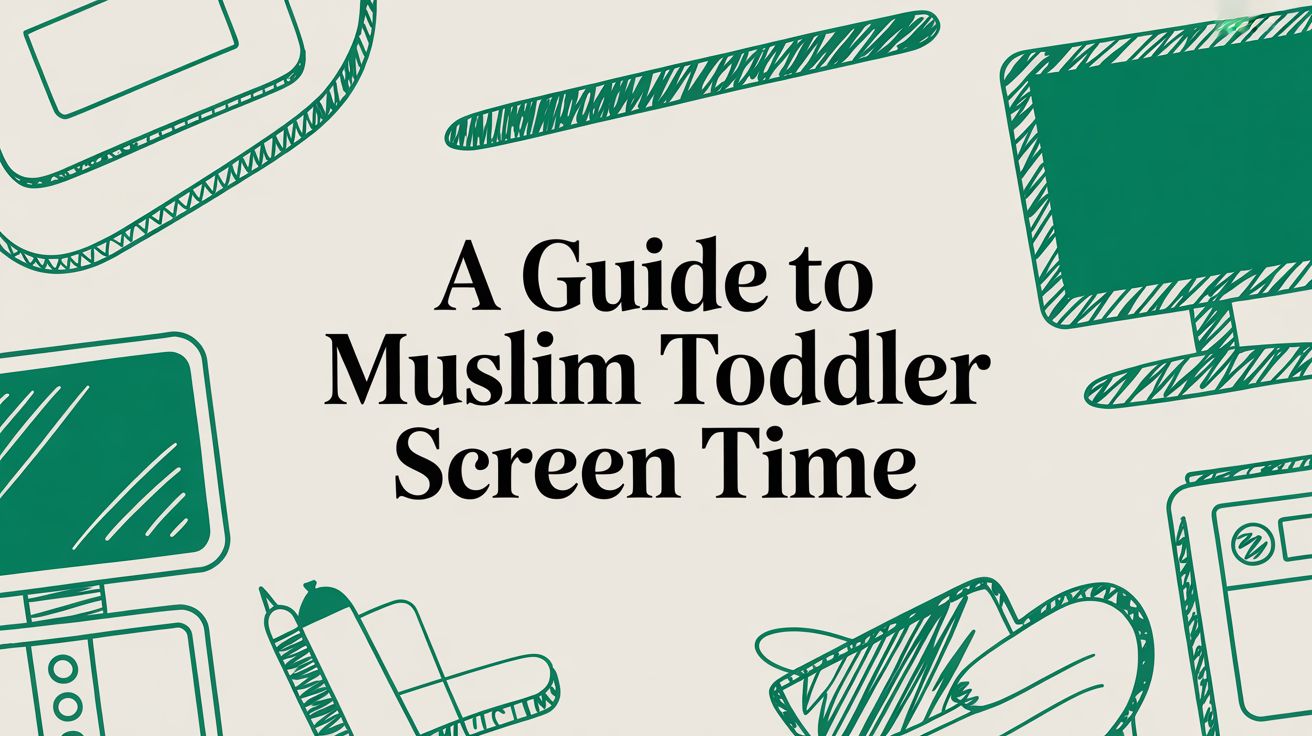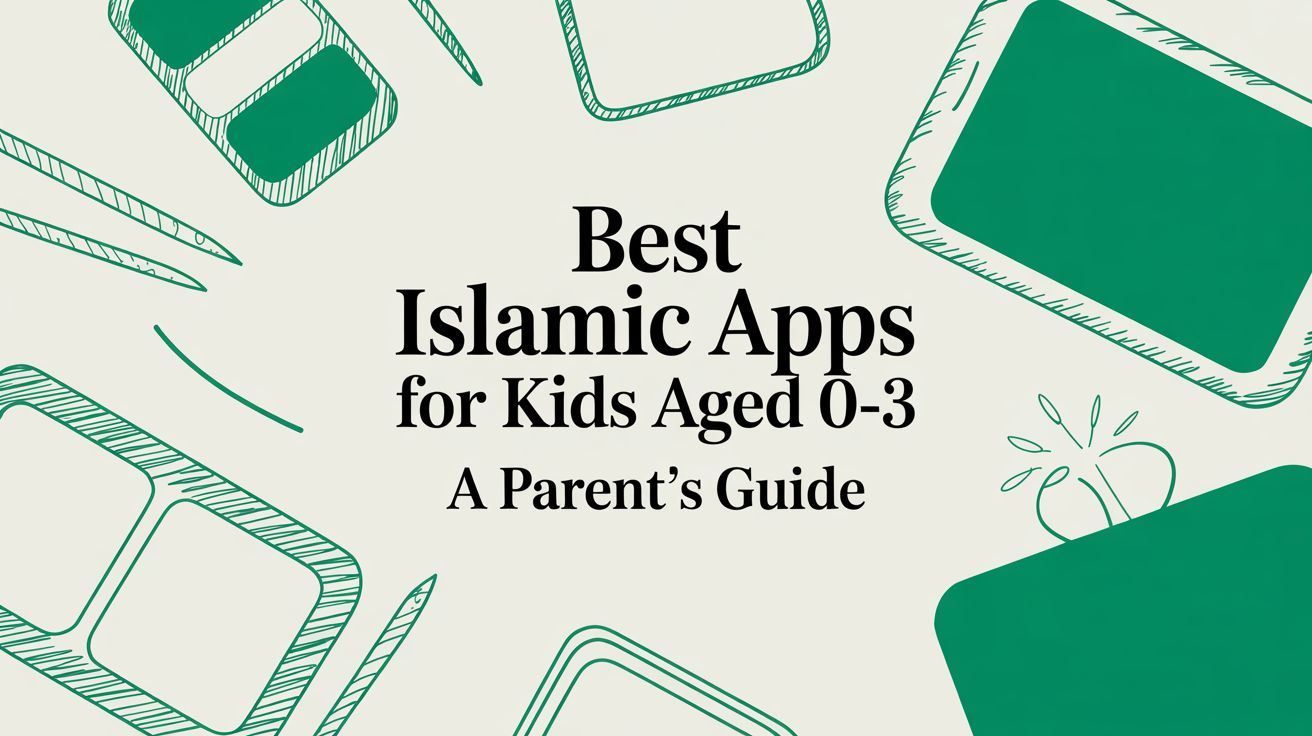The Montessori Muslim approach is a beautiful philosophy that weaves together the time-tested principles of Montessori education with the core values of our Islamic faith. It’s less about buying specific toys and more about cultivating a peaceful, respectful home that nurtures your child's innate curiosity and honours their fitra—their pure, natural disposition.
What a Montessori Muslim Home Really Looks Like
When you hear "Montessori," it's easy to picture those minimalist rooms with perfectly arranged wooden toys on low shelves. While that aesthetic is part of it, the true spirit of a Montessori Muslim home is much deeper. It's about viewing your child as an amanah, a sacred trust from Allah, and crafting a world that respects their incredible, God-given potential right from the start.
This isn't some rigid system you have to force into your life. Think of it as a framework that gives structure to the gentle, intentional parenting many of us already strive for. It gives a name to what you might naturally be doing—honouring your child's pace, fostering their independence, and creating a calm, predictable space where they can flourish.
Aligning Fitra with Foundational Principles
At its heart, the Montessori method is about observing and "following the child." It’s built on the trust that children have an internal drive to learn. This aligns perfectly with our Islamic concept of fitra, the pure state every child is born in, with a natural inclination towards truth and goodness.
Your role, then, isn't to be a teacher who pours knowledge into an empty cup. Instead, you are the thoughtful guide who prepares the environment where their fitra can blossom. When your two-year-old toddles over with a tiny prayer mat to place beside yours during Salah, a Montessori perspective sees it not as a distraction, but as their fitra in action—a beautiful, innate drive to connect with you and participate in the worship of Allah.
A Montessori Muslim home is where faith isn't just taught; it's a lived reality. It’s woven into the very fabric of daily life through observation, participation, and a deep, abiding respect for the child's developmental journey.
This child-led approach has found a home across the globe. The 2022 Global Montessori Census documented an impressive 15,763 Montessori schools in 154 countries, a testament to its universal appeal. While many of these are private institutions, the core principles are completely accessible and can be implemented right in your own home.
This concept map shows how the two pillars of this approach—respect for the child and a prepared environment—come together to form the foundation of a thriving Montessori Muslim home.

As you can see, these ideas aren't separate. They're deeply interconnected, creating a holistic environment that nurtures both your child's growing independence and their blossoming spiritual identity.
More Than Just Wooden Toys
It’s so easy to get caught up in the aesthetics, but you truly don't need a big budget for expensive materials to start. The real focus is on providing purposeful, real-world activities that help your child build concentration and confidence, one small step at a time.
Here’s what that might look like in your home:
* Practical Life Skills: This is the heart of it all. Letting your toddler help pour water (even if it spills!), wipe the table with their own small cloth after a snack, or sort colourful socks from the laundry. These aren't just chores; they are powerful lessons in motor skills and responsibility.
* Sensory Exploration: Create a "treasure basket" with different textured fabrics, smooth pebbles from the garden, or fragrant (and safe) spices like cinnamon sticks. This grounds them in the sensory beauty of Allah’s creation.
* Order and Routine: Having a designated, low shelf with just a few chosen activities is a game-changer. It builds a sense of order and predictability that is incredibly calming for babies and toddlers. When they know exactly where their favorite puzzle belongs, they also learn the simple, satisfying rhythm of putting it back. You can learn more about choosing the right toys in our guide to shape toys for toddlers.
At the end of the day, a Montessori Muslim home is a mindset. It’s about slowing down, observing your child with wonder, and trusting in the beautiful, perfect way Allah has designed them to learn and grow.
Creating a Calm and Faith-Centered Environment
Bringing Montessori into your Muslim home isn't about getting that Pinterest-perfect look. It’s about thoughtfully carving out a corner of your home—no matter how small—that speaks to your child's needs and gently nurtures their growing connection to Allah.
The real goal is to design a space that says "yes" to your child. A safe, accessible, and faith-centered area where they feel empowered to explore on their own. This could be a small corner of your living room, a low shelf in their bedroom, or even just a designated mat on the floor. Where it is matters less than the intention behind it: to bring order, beauty, and purpose into their world in a way that feels completely natural to your family's Islamic rhythm.
Starting with a Simple Prepared Space
One of the cornerstones of Montessori is the "prepared environment." For a baby or toddler, this simply means creating a space that’s physically within their reach and mentally engaging, but never overwhelming. This allows them to make their own choices, get lost in an activity, and build that incredible concentration muscle from a very early age.
Just try to see the world from their height. A room overflowing with massive toy bins can feel chaotic. But a low, open shelf with just three or four carefully chosen activities? That’s an invitation to be curious and focused. That sense of order is incredibly calming for a young child and gives them the security they need to learn.
This idea is beautifully captured in schools like Aya Montessori in Maryland, which designs its classrooms to reflect the Islamic value of ihsaan (excellence and beauty). They create spaces that invite "peace, purpose, and wonder," proving that the environment itself is a powerful teacher.
Practical Ideas for Your Faith-Centered Corner
The best part? You don't need to buy new things to get started. The most impactful Montessori Muslim spaces often come from using simple, everyday items that connect your child to both practical life skills and their Islamic identity. It’s all about making things accessible and purposeful.
Here are a few ideas to get your own creativity flowing:
- A Child-Sized Wudu Station: Find a low stool or tray and place a small, unbreakable bowl, a tiny pitcher with a little water, and a soft towel on it. Your toddler can practice pouring water and wiping their hands—a fantastic practical life skill that also gently introduces them to the rituals of salah.
- A Cozy Reading Nook: A few cushions on the floor next to a low basket is all it takes. Fill it with a handful of sturdy Islamic board books showing simple illustrations of the Kaaba, beautiful Arabic calligraphy, or stories about Allah's creations. This little retreat becomes a peaceful spot for quiet connection.
- An 'Allahu Akbar' Shelf: Dedicate one low shelf to items that spark a connection to the deen. This could be a set of soft prayer beads (tasbih), a small, child-friendly prayer mat they can practice rolling and unrolling, or a simple set of wooden blocks with Arabic letters.
The most beautiful Montessori Muslim spaces aren't about how much you spend. They're about how much thought you put into making faith tangible, accessible, and joyful for your little one. It’s about creating an environment where their natural fitra—their innate inclination towards Allah—can truly flourish.
Managing Real-Life Challenges
Of course, life in a busy family home isn’t always calm and ordered. The reality of creating a Montessori-inspired space often means getting creative and being patient with the beautiful chaos of family life.
Living in a Small Space?
You don’t need a dedicated playroom. A single low shelf, like the IKEA KALLAX laid on its side, works perfectly as a "work station" in the corner of a living room. The secret is to use trays or small baskets to contain each activity. This visually defines the workspace for your child and makes cleanup simpler.
Juggling Multiple Children?
If you have older kids, it helps to create a designated "toddler-safe" zone where only their age-appropriate activities are kept on low shelves. You can get older siblings involved by explaining that these are their younger sibling's special "work" materials, which helps foster a lovely sense of respect and responsibility.
Using What You Already Have
Before you click "add to cart," take a walk around your home. You’d be surprised what you can find.
* An old spice rack can be perfect for holding small items.
* Baskets you already own are great for organizing materials.
* Kitchen utensils like tongs, spoons, and small bowls are fantastic for transferring activities that build those crucial fine motor skills.
By focusing on simplicity, order, and faith, you can transform any corner into a meaningful Montessori Muslim space. It becomes a place where your child can build independence, develop focus, and feel the beauty of their Islamic identity woven into the fabric of their everyday world.
Simple Activities to Nurture Your Child's Iman
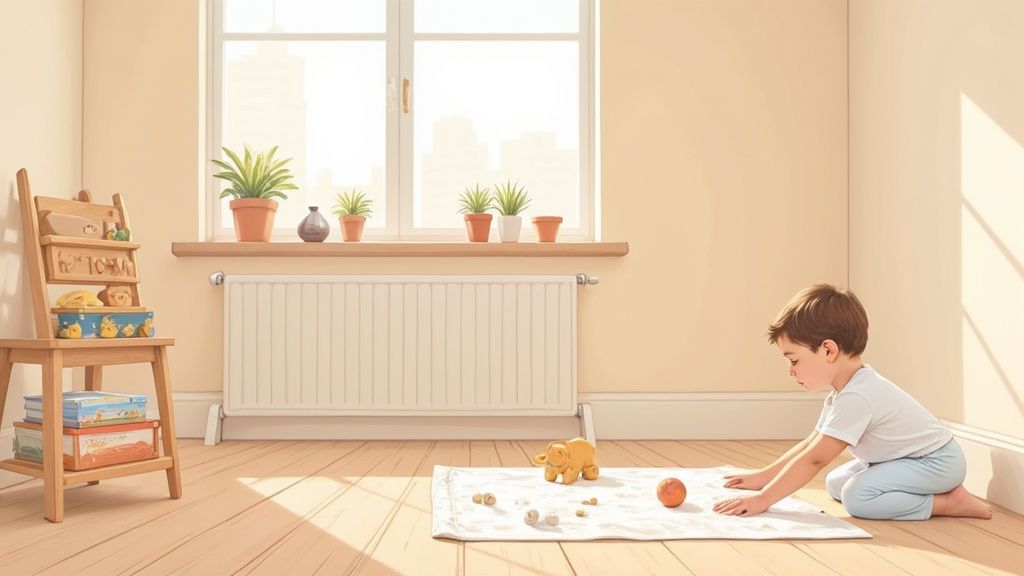
Bringing faith into your little one's life isn't about formal lessons or complicated crafts at this age. For our youngest children, iman is absorbed through simple, joyful moments—connecting with you, their home, and the beauty of Allah's creation around them.
The idea is to offer hands-on, screen-free activities that meet them right where they are developmentally. It's about making faith a tangible, delightful part of their world. Think of it as letting them absorb Islam's essence through their senses: feeling the smooth beads of a tasbih, hearing the gentle rhythm of Quran, and seeing the wonder of a ladybug on a leaf.
For Your Baby (0–1 Year): Sensory Explorations
In that precious first year, your baby is learning about the world entirely through their senses. Creating a rich sensory environment with gentle Islamic touches is a beautiful way to lay the very first foundations of faith. The goal here is gentle exposure, not overstimulation.
Soothing Sounds of Dhikr: Try playing quiet, calm Quran recitation or instrument-free nasheeds during peaceful moments, like before a nap or during a gentle feed. The rhythmic sounds can be incredibly soothing for a baby’s developing nervous system and brings a serene atmosphere into the home.
High-Contrast Islamic Cards: A newborn's vision is still developing, and they are naturally drawn to bold, high-contrast images. You can find or make simple black-and-white cards with images like the Kaaba, a crescent moon, or the word "Allah" in calligraphy. Show them these cards during tummy time to help their visual tracking skills.
A Touch of Barakah: A "treasure basket" filled with safe, natural items is a wonderful idea. You could include things like a large, smooth tasbih (prayer beads), a small square of soft fabric from a prayer mat, or a silky kufi cap. As they grasp and explore these items, they’re experiencing different textures and shapes connected to our faith.
These gentle activities are all about creating positive, peaceful associations. You’re surrounding them with the sights and sounds of your family's faith in a way that feels calm and right for their age, building a foundation of comfort and belonging from day one.
For Your Toddler (1–3 Years): Purposeful Play
As your baby blossoms into a curious toddler, their world explodes with a desire to do everything "by myself!" This is the perfect time to introduce what Montessori calls "practical life" activities—simple, real-world tasks that build independence, coordination, and focus.
When we give these tasks an Islamic twist, we seamlessly connect their natural drive to learn with the beautiful practices of our deen. These practical life skills empower your child, build their confidence, and make them feel like a valued part of the family.
Here are a few ideas to get you started:
Pouring for a Purpose: Toddlers love to pour. Set up a small tray with two unbreakable pitchers. Fill one with dry lentils, rice, or even water. This is a classic activity for building fine motor skills. You can say, "We're practicing pouring so you can help get the lentils ready for iftar one day, insha'Allah!"
Polishing Prayer Beads: Give your toddler a soft cloth and a large, sturdy set of prayer beads (make sure they're too large to be a choking hazard). Show them how to gently polish each bead. This simple, repetitive motion is fantastic for building their concentration.
Laying Out the Prayer Mat: This is a wonderful way for them to feel involved in salah. Show your toddler how to carefully unroll and then roll up their own small prayer mat. It teaches them about sequence and taking care of special objects, all while making them feel included in this core rhythm of your family's day.
The goal is to invite participation, not demand perfection. When your toddler joins you in these simple rituals, they are learning that their faith is not just something to watch, but something to live.
This whole approach of weaving faith into a child-led framework is central to the Islamic Montessori philosophy. It’s a thoughtful blend of Maria Montessori's proven principles with our beautiful Islamic teachings, creating something truly special for our children.
Connecting with Allah's Creation
Nature is one of our greatest teachers. A simple walk in the park or even just watching ants on the pavement can become a profound lesson in appreciating Allah's power and creativity.
Nature Walks of Wonder: As you walk, use simple, heartfelt language to point out the marvels around you. "Subhan'Allah, look at the beautiful red flower Allah made!" or "Allahu Akbar, feel how strong the wind is today." This connects the world they see and feel directly to the greatness of their Creator.
Collecting Nature's Treasures: Give your toddler a little basket to collect interesting leaves, pebbles, or pinecones. When you get home, you can sort them by color or size—a great early math activity that also celebrates the diversity of creation.
Story Stones for Prophets: Collect a few smooth, flat stones. On each one, you can draw a simple symbol representing a story of a Prophet—an ark for Nuh (AS), a whale for Yunus (AS), or a staff for Musa (AS). Use these stones as visual aids to tell simplified, age-appropriate versions of these stories. This tactile method helps make the stories more memorable. To deepen your own understanding and share beneficial knowledge with your child, consider learning and reciting the powerful dua, "Allahumma inni as'aluka ilman nafi'an," which asks for beneficial knowledge.
Every activity, from pouring lentils to finding the perfect leaf, is a chance to nurture your child's iman. By offering these simple, joyful, and purposeful experiences, you are helping them build a loving and positive connection to their faith that will, insha'Allah, last a lifetime.
Building a Daily Rhythm Around Your Faith
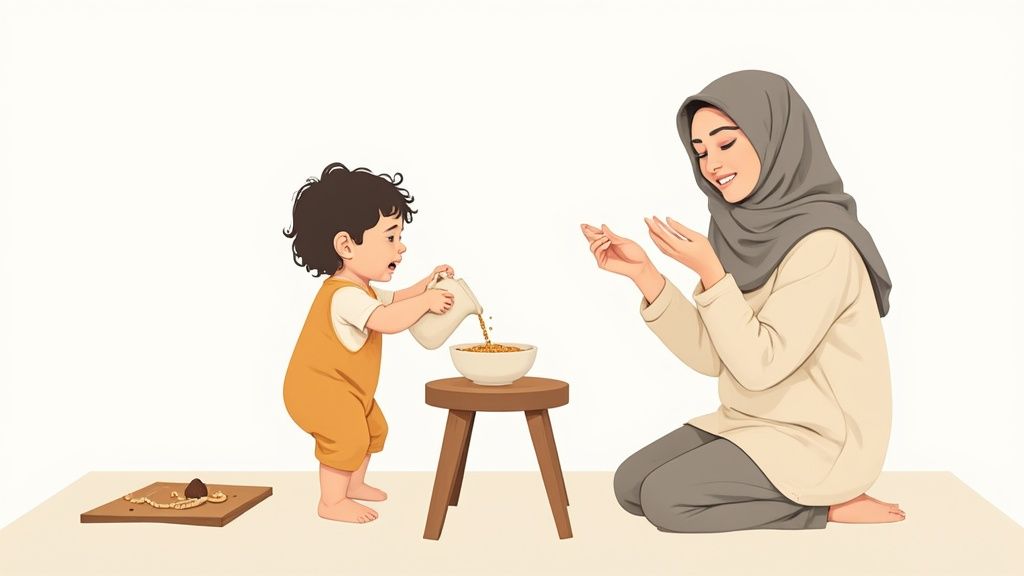
Life with a toddler can feel like a whirlwind. A gentle, predictable daily rhythm is the anchor that brings calm and security to their world—and, let's be honest, to ours too.
This isn't about rigid schedules. It’s about creating a soft, flowing sequence of events that your child can anticipate. When they know that playtime follows breakfast, and a quiet story comes before their nap, their world feels safe. For a Muslim family, this rhythm naturally finds its pulse around the beautiful pillars of our day: our prayer times.
Weaving Faith into Your Daily Flow
Integrating Islamic practices into your day doesn't have to feel like another chore. Instead of seeing prayer times as interruptions, we can reframe them as gentle, consistent points of connection that anchor the entire family.
Think about the adhan softly playing in your home. This beautiful sound can become a cue—not just for salah, but for a transition. It might signal that it’s time to put away the playdough and help you lay out the prayer mats. This simple, repeated action builds a powerful association in your child's mind between the call to prayer and a peaceful, shared family ritual.
The key is making these transitions smooth. A simple five-minute warning can make all the difference for a toddler. Saying, "In five minutes, when we hear the adhan, we'll tidy up for Maghrib prayer," gives them the respect and processing time they need to switch gears without a meltdown.
Creating a Visual Rhythm for Your Toddler
Toddlers can't read clocks, but they are brilliant at understanding pictures. A simple visual schedule, hung at their eye level, can be a game-changer for helping them understand the flow of their day and feel more in control.
You can easily make one yourself with simple drawings or photos:
* A picture of a bowl for mealtime.
* An image of a prayer mat for salah.
* A drawing of blocks for independent play.
* A picture of a book for storytime before a nap.
Point to the pictures throughout the day. "Look, we just finished breakfast! Next, it's time to play." This simple tool empowers them by making the abstract concept of time something they can see and understand.
A predictable rhythm does more than just organize your day; it builds a foundation of trust and security for your child. When their basic needs for routine are met, they are free to focus on the important work of learning and discovery.
Adapting Montessori principles within an Islamic framework is becoming more common. Researchers are noting how educators are skillfully blending these methods with Islamic knowledge to create cohesive daily routines in classrooms. It’s exciting to see how this thoughtful approach is being applied in formal educational settings.
Navigating Special Times with Grace
Our Islamic calendar brings beautiful seasons like Ramadan and Eid, which naturally shift our daily flow. A Montessori approach helps us navigate these changes with flexibility and grace, always keeping our child's needs at the center.
Ramadan with a Toddler
During Ramadan, your own energy levels and meal times will change. It’s important to maintain your toddler’s core rhythm of eating and sleeping as consistently as possible, even as your own schedule shifts.
- Involve them in Iftar Prep: Give them a simple, safe task like washing dates or tearing lettuce for a salad. This makes them feel like an important part of the special preparations.
- Create a Quiet Iftar Corner: Keep a small basket of quiet activities—like Islamic-themed colouring pages or soft books—ready for them while the adults are breaking their fast. This allows you to have a peaceful moment while keeping them happily occupied nearby.
Preparing for Eid
The excitement of Eid can be overwhelming for little ones. Involving them in the preparations in a calm, child-led way can make it a joyful experience instead of a stressful one.
- Baking Together: Let them help stir the batter for Eid cookies or sprinkle on decorations. Remember, it’s about the process, not a perfect outcome.
- Gift Wrapping Station: Set up a tray with some paper, child-safe scissors, and tape. They can "wrap" small gifts for family members, developing fine motor skills while participating in the loving act of giving.
By creating a flexible rhythm that honors both your faith and your child's developmental needs, you build a peaceful and predictable home. This is a core part of the Montessori Muslim journey—crafting a life where Islamic practice and early childhood development flow together beautifully. For more in-depth guidance, check out our guide on creating a Muslim toddler routine.
Nurturing Language in a Multilingual Muslim Home
So many of our homes are a beautiful mix of languages. We might speak English day-to-day, a heritage language that connects us to our grandparents, and of course, Arabic—the language of our deen. Raising a multilingual child is one of the greatest gifts we can offer, and the Montessori way provides a gentle, natural path to get there.
The whole idea is to lean into your toddler's "absorbent mind." They don't learn to walk by studying diagrams; they just do it. Language is the same. Our job is to create a rich environment where they can soak it all in.
One Person, One Language and Other Gentle Strategies
A tried-and-true method many families find success with is "One Person, One Language" (OPOL). It's quite simple: Mama might consistently speak Urdu, while Baba speaks English. This clear boundary helps your little one naturally sort the languages in their mind.
But that's not the only way. Some families prefer the "Minority Language at Home" approach, where your heritage language becomes the main language of the house. Others might set aside specific times for a language—maybe you only speak Arabic when you're looking at Quranic storybooks together.
What matters most is being consistent and keeping the experience positive. You want every language to feel like a warm, joyful part of who your family is.
Making Language Tangible and Fun
In a Montessori-inspired Muslim home, we move away from flashcards and drills. Instead, we weave language into the fabric of our day, connecting words to real, touchable things.
Here are a few ideas you can try:
- Label Your World: Create simple labels for things around your home in Arabic or your heritage language. A label on the door (باب - baab), the window (شباك - shubbak), or their favourite chair (كرسي - kursi) turns your home into a living dictionary.
- Sing Together: Nasheeds are a wonderful tool for language learning. Find simple, instrument-free nasheeds in the languages you're focusing on. The rhythm makes vocabulary stick, whether you're singing about the Arabic alphabet or a lullaby in your mother tongue.
- Bilingual Story Time: Build a little library of board books that include multiple languages. When you point to the pictures, say the word in both English and your other language. "Look, a cat! In Urdu, we call that a billi."
When you immerse your child in a rich linguistic environment, you're doing so much more than just teaching words. You're handing them the keys to unlock different parts of their identity—their culture, their faith, and their connection to the wider Ummah.
Embracing the "Silent Period"
Don't be surprised if your multilingual toddler goes through a "silent period." This is a phase where they're absorbing everything like a sponge but might not be saying much out loud. It can feel a little worrying, but trust the process.
Their brain is working incredibly hard, building the complex pathways needed for multiple languages. Instead of pushing them to speak, just keep the conversations going. Talk to them, sing with them, and read to them in all your family’s languages. When they’re ready, the words will start to flow, often in a beautiful, unique blend that is all their own.
Common Montessori Muslim Questions Answered
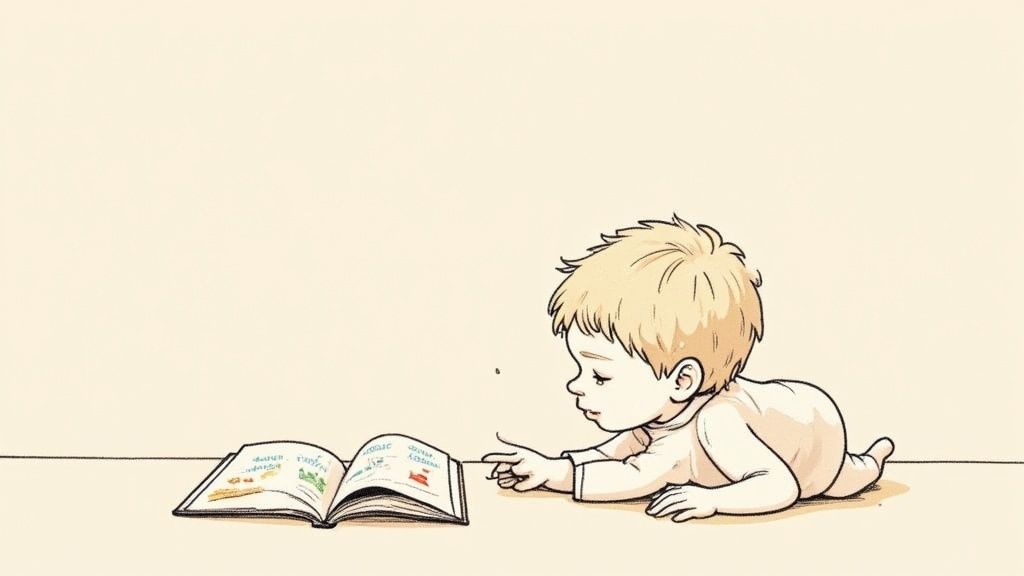
Whenever you start a new parenting journey, questions pop up. And when you’re blending Montessori with your faith, it's normal to wonder how it all works—with your family, your budget, and your Islamic values. Let's walk through some of the most common questions from parents just starting out.
My hope is to reassure you that this approach is not only possible but can be a beautiful way to nurture your child's innate goodness, their fitra.
Is Montessori Truly Compatible with Islam?
This is a big one. Many parents worry that Montessori is just another Western philosophy that won't align with our deen. But when you look closely at its core ideas—like deep respect for the child, encouraging independence, and connecting with nature—you’ll find they resonate beautifully with Islamic principles.
The point is to honor the child’s natural disposition (fitra), which is exactly what we’re called to do in Islam. It's not about adopting a rigid, secular curriculum. Instead, you take the foundational principles and weave them into your Muslim home. For instance, your "prepared environment" can be set up to make wudu and prayer feel natural and accessible, even for a tiny toddler.
Do I Need to Buy Expensive Wooden Toys?
Absolutely not. This is probably the biggest misconception, and it's one that can make Montessori feel out of reach. The heart of a Montessori Muslim home isn't about fancy brands; it's about the purpose behind the activities you offer.
You can create a wonderfully engaging and educational space using things you already have.
Some simple, no-cost activities include:
* Pouring water between two small jugs during bath time.
* Sorting spoons and forks while you unload the dishwasher.
* "Helping" you fold small laundry items like washcloths.
* Playing with homemade salt dough.
The real focus is on meaningful, hands-on work, not collecting a specific set of toys.
How Do I Handle Discipline Gently?
Montessori discipline fits perfectly with the Islamic concept of raising children with mercy and guidance, often called tarbiyah. Instead of focusing on punishments, we look to understand the need behind our child's behavior and guide them with compassion. This approach mirrors the Prophetic example of raising children with wisdom and kindness.
It's about setting clear, respectful boundaries ("We use gentle hands with the cat"), preparing the home to minimize conflict (like moving a fragile vase out of reach), and connecting with your child to see what’s really going on. The goal is to teach, not to shame.
How Can This Help My Toddler's Short Attention Span?
First, know that it’s completely normal for toddlers to bounce from one thing to the next! Their brains are wired for exploration. Montessori actually helps build that muscle of concentration over time, not by forcing it, but by offering activities that are so captivating they can’t help but focus.
The trick is to watch your child closely. See what they’re naturally interested in. Then, present a single, simple activity on a small tray or mat, free from other distractions. Keep the activity short and sweet, and don't be afraid to rotate things often to keep them fresh. Insha'Allah, as they master these small tasks and feel that sense of accomplishment, you'll see their ability to focus grow.
Finding media that aligns with these gentle, faith-centered values can be a real challenge. That's where Babymode comes in. We offer a safe, halal, and completely ad-free screen-time experience designed specifically for Muslim toddlers. Our AI-generated content is carefully reviewed to align with Islamic values, giving you peace of mind and your child purposeful entertainment. Join the Babymode waitlist for early access.
